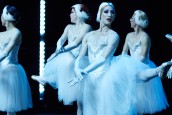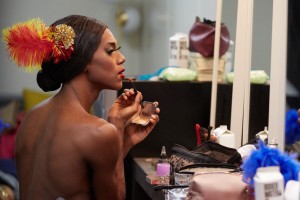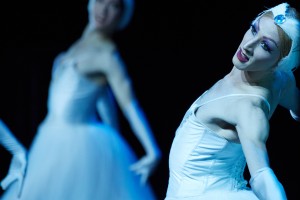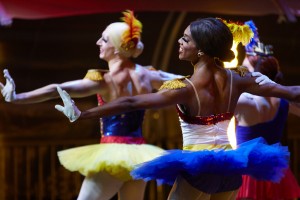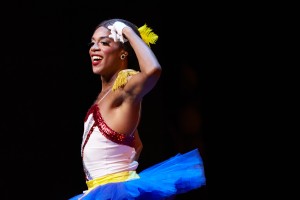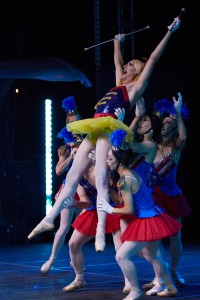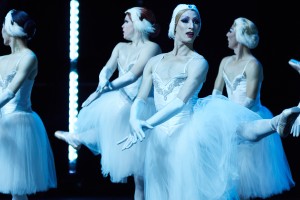BALLERINA BOYS, a documentary about the all-male comedy ballet troupe Les Ballets Trockadero de Monte Carlo, airs on AMERICAN MASTERS on PBS Friday, June 4. Founded in 1974, the Trocks, as they are affectionately known, put a humorous spin on classical ballets, with company members performing the female roles in drag.
BALLERINA BOYS is directed and produced by Martie Barylick and Chana Gazit. Gazit has been a documentary filmmaker for thirty-five years. Among her multiple awards wins are Emmys for 2005’s SLAVERY AND THE MAKING OF AMERICA, THE PILL on PBS’s 1988 AMERICAN EXPERIENCE, and 1991’s HONORABLE NATIONS.
Barylick, who has been both a dancer and a choreographer is currently a professor at New York University’s Steinhardt School and at Rutger University’s Mason Gross School of the Arts. Barylick herself has been the subject of the documentary TEACHING IN AND THROUGH THE ARTS.
In a telephone interview, Barylick and Gazit discuss BALLERINA BOYS.
ASSIGNMENT X: How did the two of you come together as directors?
CHANA GAZIT: So, I’m the film person, I’m the documentary person, and Martie is the dance person. Really, we’re best friends who started out in a mutual experience of having had ill husbands that we were caretaking, and who have since died. That created this bond. And on New Year’s Eve 2014, turning to 2015, Martie had the great idea of going to see this Trockadero de Monte Carlo at the Joyce Theatre, which was my first time.
MARTIE BARYLICK: But, like, my fifteenth [laughs].
GAZIT: Martie was incredibly familiar [with the Trocks]. And that was it. It was almost instantaneous that we decided to go on this crazy journey of getting this film off the ground.
AX: Did PBS and AMERICAN MASTERS help you make BALLERINA BOYS, or did you go to PBS after it was completed?
GAZIT: So, at first we started just by trying to fundraise, which as you know is an incredibly difficult process. We did manage to raise some money that allowed us to do filming, so that we actually had a sample of what to show. But then, IPBS, which is an offshoot of PBS as a granting organization, gave us our biggest chunk, which really allowed us to film the tour of North and South Carolina, which was a two-plus-week tour that [the Trockadero] took, and we lived with them that whole time, on the bus. AMERICAN MASTERS really kicked in, in 2020, and basically gave us the money to edit and to finish the film. There was no completed film when they came in. They knew what we had shot, and said, “Can you edit this, get this done, by the end of 2020?” Somehow, we did.
AX: Since Les Ballets Trockadero has been performing for almost fifty years, was it difficult obtaining the archival footage of the troupe?
GAZIT: Not at all, because the Trocks had done a really, really good job of collecting, and [it’s] their archive. And so, fairly early on, they just handed us a hard drive. Of course, we had to supplement, and do our own research, and we’re doing all of this in the pandemic year, in 2020, but we really had that wonderful archive that they handed over to us.
BARYLICK: And we had wonderful access to the company, starting with Tory Dobrin, the artistic director. And then everybody else. We built a lot of trust, I think. It was a pleasure to do that.
AX: One of the current Trockadero dancers, Philip Martin Nielson, discusses his autism, and is shown teaching a ballet class for children who have autism. Is he the only one who has a side job, or was his the most interesting side job?
BARYLICK: Philip was allowed by his [dance] teacher to teach at a very young age. I don’t know that he did that as a supplementary gig to earn money, because you don’t, really. He did it because he loved it. He did the teaching of the autistic kids, I think, to stay in touch with his former self. And Duane [Gosa] is a member of at least one other dance company. It’s so hard to say, because it’s all been down [due to COVID] for fifteen months. But when life was normal, Duane was also dancing with a modern dance company, a little bit more commercial.
GAZIT: I think all of them, because they’re complete human beings, had other things that they did. But we were very struck by Philip, and Philip’s story, and the opportunity to film that class.
AX: In BALLERINA BOYS, when you’re interviewing former Trock dancers, those who are still with the company and those who are emeritus, you give their full names. With the current dancers, you only give the first names. What is the reason for that?
GAZIT: [laughs] We talked a lot about that. Martie, you’re going to have to refresh my memory, but I think we thought, because they were part of a company – in some ways, the biggest character, the character in the film, is the company. Which is why it was so wonderful that AMERICAN MASTERS, which is a brilliant series, took us on. Because usually, their masters are individuals. In this case, it was going to be the company.
BARYLICK: An institution.
GAZIT: Yes. And so, I think part of our rationale was that, by giving just their first names, that we hold onto that sense of the institution.
AX: So, it was like, the Trockadero is the master, and then these dancers are part of that master.
GAZIT: Right.
AX: Do you think the Trocks play any differently, and are received by the audience any differently, in the current era? Nowadays, most of the audience is familiar with the concept of gender fluidity, as opposed to when the Trocks started, when the idea of male ballerinas was much more uncommon …
BARYLICK: I can start on that. I think what they’ve lost in raw edginess they’ve made up for in complexity and subtlety. I think that, as [Les Ballets Trockadero co-founder] Peter [Anastos] says, in the original days, anybody who saw that performance was probably seeing a gay person for the first time in their life. So, the edge was very sharp. I think now, that’s just not the case. People are much more relaxed and understanding – except, as Peter says, for “the people who hated us” [laughs]. He’s just so wonderful. I do think that they have evolved in just a wonderful way, given circumstances. Now, they have to dance much better, and they have to be perfect in their comic timing, and they have to channel those ballerinas of the past, just to give us this incredibly rich performance.
GAZIT: Martie, see if you agree – in some ways, I think the biggest change is actually on the technical level. As every year went by, they became better and better technically, and now it’s been that way for quite a while. There’s just a commitment to absolute technical excellence. So, where they may have leaned towards camp in the early years, that is long gone. And instead, there is this absolute technical mastery of ballet.
AX: And did you guys have any thoughts about, “Okay, how do we film and edit the ballet sequences, because obviously, we want to see their feet and their legs and their arms, but on the other hand, we want to get the comic facial moments?”
BARYLICK: That was the really fun part [laughs].
GAZIT: I think that the reason we were able to capture the dance as well as we did was, one, we have this brilliant cinematographer, Claudia Raschke, who herself is a former dancer. And then, I think even more to the point is that Martie has this, I don’t know what you call it, but it’s like a muscle memory. She could remember the dance. So, she could anticipate when a section was coming up that would be important for the camera to capture. I just had no ability to do that as a film person. But, as a dance person, she was able to fully absorb and have the dance imprint in her mind, so that she can direct the camera to capture those things. Once we got in the editing room, we were, at that point, given the gift of having had these really wonderful moments captured.
BARYLICK: And I’ve got to say, we also had the gift – thank you, Chana, for developing so many great relationships in your professional life. I get the be the one who says that Chana has six Emmys on her bookshelf. But you brought us our editor, E. Donna Shepherd, [who] was a genius, and that was really the fun part.
GAZIT: So, without really meaning to, this was very much an all-woman production [laughs].
AX: Do you think the all-woman production team gave BALLERINA BOYS anything in terms of working with the all-make Trocks?
GAZIT: Well, the Trocks’ crew is predominantly female. I think there’s an interesting dynamic there. We made them comfortable, I think. I think in some ways, they viewed us as very grandmotherly figures. Wouldn’t you agree, Martie? And I think that helped create a sense of trust among the dancers, which we worked very hard to build by just spending a lot of time with them.
BARYLICK: We were very gratified, because after the tour, one of the dancers said, “We all noticed that we danced so well when you guys were filming.”
AX: What was the balance between stuff that you knew yourselves, but were asking about because you wanted to have the answers on record for the camera, and stuff that you were genuinely curious about and were asking, or looking at, because you actually wanted to know the answers?
GAZIT: As a film person, you know you have to get certain information captured, especially because we knew this was going to be a non-narrated film. So, you’re always thinking about how to make sure you lay down the foundation of having enough information to tell the story. But beyond that, I would say for me, and Martie may have a different answer, their world was so foreign – the performers, people who tour, the way they understood themselves within the context of drag, and the drag community, and what they understood about drag – there was just a lot of area that I just really wanted to know [about]. So, it was very much an exploration on my part, and them educating me. I started the film in a different place than how I ended. So, there was a fair amount of just sheer exploration.
AX: Is there anything different about doing a dance documentary than some other type of documentary?
BARYLICK: Ooh, hit it, Chana.
GAZIT: I never necessarily felt [prior to BALLERINA BOYS] that I needed a partner to make a film. I always felt like I could master the subject on my own – film is an intensely collaborative process, but I didn’t feel like I needed a partner to understand the material. That’s where Martie was so essential to the process. As I said earlier, I don’t understand dance language. I don’t have a memory for dance. I don’t understand what their bodies were doing, and the kind of strain it was putting on their bodies. So, those were the ways that made it very different than other documentaries that I have done. It’s just really doing justice to the dance.
AX: Is there a longer theatrical version of BALLERINA BOYS than what is airing on AMERICAN MASTERS?
GAZIT: I don’t think so. Originally, we thought that that would be our goal, to do a theatrical version, but just given the circumstances of COVID year, and AMERICAN MASTERS coming in, and the way this has evolved, I think this will be it. I don’t think we’ll go on to make a theatrical version.
AX: Now that the two of you have worked together on BALLERINA BOYS, are you looking for other projects where you can both bring your expertise to the subject?
BARYLICK: I don’t think there’s a project that I can imagine where I could contribute quite as much to the content of the film as I did with this one, because, yeah, you can have a content person, but what you need is the person who’s been making films for thirty-five years, and that’s Chana [laughs]. So, I was just lucky that this project evolved the way it did, so that I could – I certainly learned about filmmaking. I have another whole skill set. But also, a lifetime in the world of dance really helped, I think, in the making of this particular film. I don’t know if there’s another particular one out there that it would help.
AX: And is there anything else you’d like to discuss about BALLERINA BOYS?
GAZIT: [laughs] We had very many low points in this very difficult journey of trying to raise money for an independent film, where we almost walked away. I think what the Trocks did for us, what kept me in it, and I think Martie would say the same, was just a level of joyousness that they provide. They made us happy, and hopefully the film captured some of that, and can, especially in COVID Year 2021, bring a feel-good film, but at the same time, in the process, open people’s hearts to a wider understanding of gender.
Follow us on Twitter at ASSIGNMENT X
Like us on Facebook at ASSIGNMENT X
Article Source: Assignment X
Article: Exclusive Interview: BALLERINA BOYS Directors and producers Chana Gazit and Martie Barylick on new AMERICAN MASTERS documentary
Related Posts:




